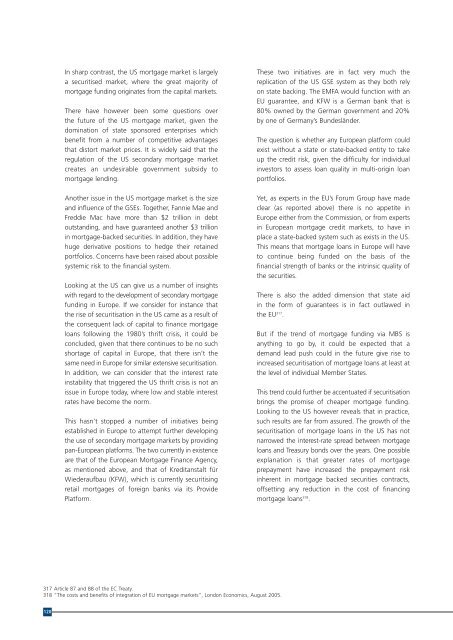A comparative analysis of the US and EU retail banking markets - Wsbi
A comparative analysis of the US and EU retail banking markets - Wsbi
A comparative analysis of the US and EU retail banking markets - Wsbi
You also want an ePaper? Increase the reach of your titles
YUMPU automatically turns print PDFs into web optimized ePapers that Google loves.
In sharp contrast, <strong>the</strong> <strong>US</strong> mortgage market is largely<br />
a securitised market, where <strong>the</strong> great majority <strong>of</strong><br />
mortgage funding originates from <strong>the</strong> capital <strong>markets</strong>.<br />
There have however been some questions over<br />
<strong>the</strong> future <strong>of</strong> <strong>the</strong> <strong>US</strong> mortgage market, given <strong>the</strong><br />
domination <strong>of</strong> state sponsored enterprises which<br />
benefit from a number <strong>of</strong> competitive advantages<br />
that distort market prices. It is widely said that <strong>the</strong><br />
regulation <strong>of</strong> <strong>the</strong> <strong>US</strong> secondary mortgage market<br />
creates an undesirable government subsidy to<br />
mortgage lending.<br />
Ano<strong>the</strong>r issue in <strong>the</strong> <strong>US</strong> mortgage market is <strong>the</strong> size<br />
<strong>and</strong> influence <strong>of</strong> <strong>the</strong> GSEs. Toge<strong>the</strong>r, Fannie Mae <strong>and</strong><br />
Freddie Mac have more than $2 trillion in debt<br />
outst<strong>and</strong>ing, <strong>and</strong> have guaranteed ano<strong>the</strong>r $3 trillion<br />
in mortgage-backed securities. In addition, <strong>the</strong>y have<br />
huge derivative positions to hedge <strong>the</strong>ir retained<br />
portfolios. Concerns have been raised about possible<br />
systemic risk to <strong>the</strong> financial system.<br />
Looking at <strong>the</strong> <strong>US</strong> can give us a number <strong>of</strong> insights<br />
with regard to <strong>the</strong> development <strong>of</strong> secondary mortgage<br />
funding in Europe. If we consider for instance that<br />
<strong>the</strong> rise <strong>of</strong> securitisation in <strong>the</strong> <strong>US</strong> came as a result <strong>of</strong><br />
<strong>the</strong> consequent lack <strong>of</strong> capital to finance mortgage<br />
loans following <strong>the</strong> 1980’s thrift crisis, it could be<br />
concluded, given that <strong>the</strong>re continues to be no such<br />
shortage <strong>of</strong> capital in Europe, that <strong>the</strong>re isn’t <strong>the</strong><br />
same need in Europe for similar extensive securitisation.<br />
In addition, we can consider that <strong>the</strong> interest rate<br />
instability that triggered <strong>the</strong> <strong>US</strong> thrift crisis is not an<br />
issue in Europe today, where low <strong>and</strong> stable interest<br />
rates have become <strong>the</strong> norm.<br />
This hasn’t stopped a number <strong>of</strong> initiatives being<br />
established in Europe to attempt fur<strong>the</strong>r developing<br />
<strong>the</strong> use <strong>of</strong> secondary mortgage <strong>markets</strong> by providing<br />
pan-European platforms. The two currently in existence<br />
are that <strong>of</strong> <strong>the</strong> European Mortgage Finance Agency,<br />
as mentioned above, <strong>and</strong> that <strong>of</strong> Kreditanstalt für<br />
Wiederaufbau (KFW), which is currently securitising<br />
<strong>retail</strong> mortgages <strong>of</strong> foreign banks via its Provide<br />
Platform.<br />
These two initiatives are in fact very much <strong>the</strong><br />
replication <strong>of</strong> <strong>the</strong> <strong>US</strong> GSE system as <strong>the</strong>y both rely<br />
on state backing. The EMFA would function with an<br />
<strong>EU</strong> guarantee, <strong>and</strong> KFW is a German bank that is<br />
80% owned by <strong>the</strong> German government <strong>and</strong> 20%<br />
by one <strong>of</strong> Germany’s Bundesländer.<br />
The question is whe<strong>the</strong>r any European platform could<br />
exist without a state or state-backed entity to take<br />
up <strong>the</strong> credit risk, given <strong>the</strong> difficulty for individual<br />
investors to assess loan quality in multi-origin loan<br />
portfolios.<br />
Yet, as experts in <strong>the</strong> <strong>EU</strong>’s Forum Group have made<br />
clear (as reported above) <strong>the</strong>re is no appetite in<br />
Europe ei<strong>the</strong>r from <strong>the</strong> Commission, or from experts<br />
in European mortgage credit <strong>markets</strong>, to have in<br />
place a state-backed system such as exists in <strong>the</strong> <strong>US</strong>.<br />
This means that mortgage loans in Europe will have<br />
to continue being funded on <strong>the</strong> basis <strong>of</strong> <strong>the</strong><br />
financial strength <strong>of</strong> banks or <strong>the</strong> intrinsic quality <strong>of</strong><br />
<strong>the</strong> securities.<br />
There is also <strong>the</strong> added dimension that state aid<br />
in <strong>the</strong> form <strong>of</strong> guarantees is in fact outlawed in<br />
<strong>the</strong> <strong>EU</strong> 317 .<br />
But if <strong>the</strong> trend <strong>of</strong> mortgage funding via MBS is<br />
anything to go by, it could be expected that a<br />
dem<strong>and</strong> lead push could in <strong>the</strong> future give rise to<br />
increased securitisation <strong>of</strong> mortgage loans at least at<br />
<strong>the</strong> level <strong>of</strong> individual Member States.<br />
This trend could fur<strong>the</strong>r be accentuated if securitisation<br />
brings <strong>the</strong> promise <strong>of</strong> cheaper mortgage funding.<br />
Looking to <strong>the</strong> <strong>US</strong> however reveals that in practice,<br />
such results are far from assured. The growth <strong>of</strong> <strong>the</strong><br />
securitisation <strong>of</strong> mortgage loans in <strong>the</strong> <strong>US</strong> has not<br />
narrowed <strong>the</strong> interest-rate spread between mortgage<br />
loans <strong>and</strong> Treasury bonds over <strong>the</strong> years. One possible<br />
explanation is that greater rates <strong>of</strong> mortgage<br />
prepayment have increased <strong>the</strong> prepayment risk<br />
inherent in mortgage backed securities contracts,<br />
<strong>of</strong>fsetting any reduction in <strong>the</strong> cost <strong>of</strong> financing<br />
mortgage loans 318 .<br />
317 Article 87 <strong>and</strong> 88 <strong>of</strong> <strong>the</strong> EC Treaty.<br />
318 “The costs <strong>and</strong> benefits <strong>of</strong> integration <strong>of</strong> <strong>EU</strong> mortgage <strong>markets</strong>”, London Economics, August 2005.<br />
120
















